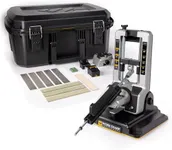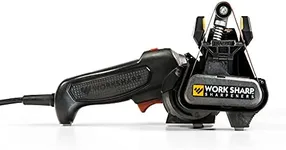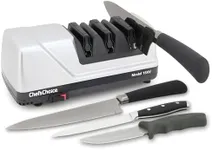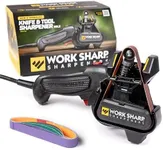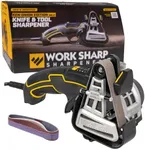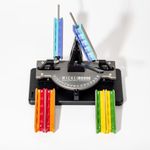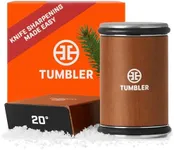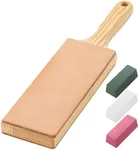Buying Guide for the Best Knife Sharpener Kit
Choosing the right knife sharpener kit is essential for maintaining the longevity and performance of your knives. A good sharpener kit can make a significant difference in the ease and efficiency of your cutting tasks. When selecting a knife sharpener kit, consider the type of knives you own, your sharpening skills, and how often you plan to sharpen your knives. Here are some key specifications to look for and how to choose the best fit for your needs.Type of SharpenerKnife sharpeners come in various types, including manual, electric, and sharpening stones. Manual sharpeners are typically more affordable and require physical effort, making them suitable for occasional use. Electric sharpeners are convenient and fast, ideal for frequent use and those who prefer a hands-off approach. Sharpening stones offer the most control and precision, perfect for those who are experienced or want to learn the art of sharpening. Choose the type based on your comfort level and how often you plan to sharpen your knives.
Grit LevelsGrit levels refer to the coarseness of the sharpening surface. Coarse grits (200-600) are used for repairing damaged edges and reshaping blades. Medium grits (800-1200) are suitable for regular sharpening and maintaining a sharp edge. Fine grits (3000 and above) are used for polishing and achieving a razor-sharp finish. If you have a variety of knives or want to maintain different levels of sharpness, a kit with multiple grit levels is ideal. Consider your sharpening needs and the condition of your knives when choosing grit levels.
Angle GuidesAngle guides help ensure that you sharpen your knives at the correct angle, which is crucial for maintaining the edge. Different knives require different sharpening angles, typically ranging from 15 to 20 degrees for kitchen knives. Angle guides can be built-in or adjustable, providing ease of use and consistency. If you're new to sharpening, look for kits with angle guides to help you achieve the best results. Experienced sharpeners may prefer kits without guides for more control.
Material QualityThe quality of the materials used in the sharpener kit affects its durability and effectiveness. High-quality materials like diamond, ceramic, and high-grade steel provide better sharpening performance and longevity. Cheaper materials may wear out quickly and not deliver the desired sharpness. Consider investing in a kit made from durable materials to ensure it lasts and performs well over time. Your choice should be guided by how often you plan to use the sharpener and the types of knives you own.
Ease of UseEase of use is an important factor, especially for beginners. Some kits come with user-friendly features like ergonomic handles, clear instructions, and safety mechanisms to prevent accidents. Electric sharpeners are generally easier to use, while manual sharpeners and stones may require more skill and practice. Choose a kit that matches your skill level and provides a comfortable and safe sharpening experience. If you're new to sharpening, look for kits with straightforward instructions and safety features.
PortabilityPortability refers to how easy it is to transport and store the sharpener kit. Compact and lightweight kits are ideal for those who need to sharpen knives on the go or have limited storage space. Larger kits may offer more features but can be cumbersome to move around. Consider your storage space and whether you need a portable option when choosing a sharpener kit. If you travel frequently or have a small kitchen, a portable kit may be more suitable.

